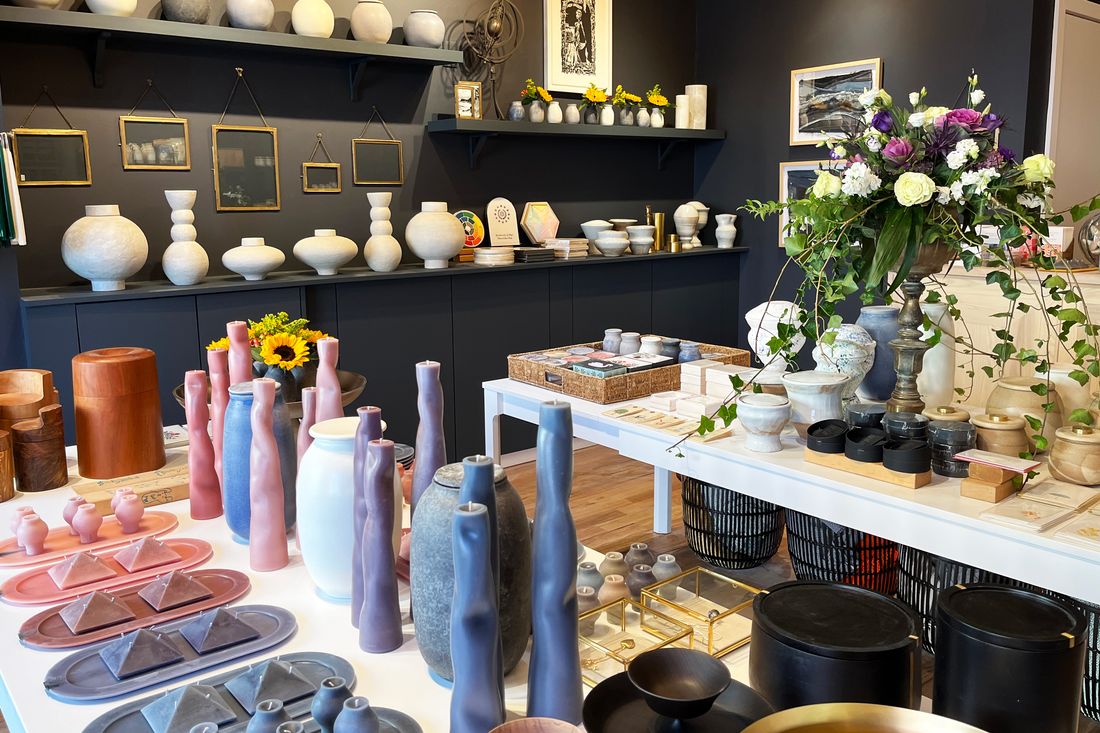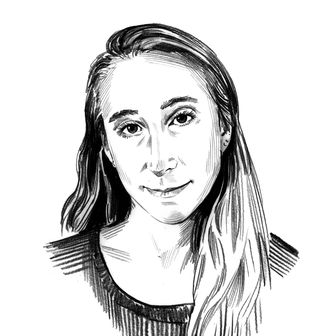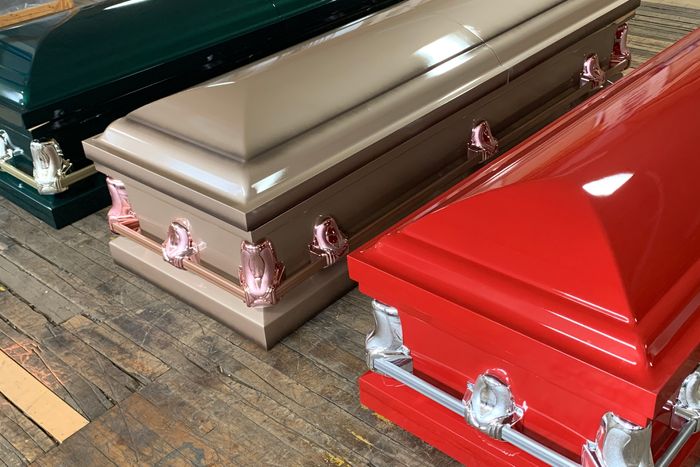
“We’ve had people come in thinking we were a spa; to me that’s a win,” said Erica Hill, the co-owner of Sparrow, a business that opened last November in Greenpoint. Sparrow does, indeed, look very spalike: the décor is pleasantly neutral, with skylights, pastel murals, and a retail storefront on Driggs Avenue that stocks candles, cashmere throws, bath products, and some very nice ceramic vessels made by local women. It’s not until you look a little closer at the titles of the books or move into the main establishment, where the rooms are filled with rows of empty chairs, that the space’s true nature becomes apparent: Sparrow is a funeral home, and those nice pieces of pottery are cremation urns. Hill wanted the shop to be warm and inviting in order to draw in passersby — a route into, if not the next world, then a preliminary conversation about it. “People are given a door to peep in, to walk through,” said Hill. “I feel strongly we don’t talk enough about death and dying. And we don’t plan for it. But everyone is going to die; you can’t get away from that one.”
In addition to arranging funerals, Sparrow also hosts exit parties — gatherings for the dying but not yet dead, to say good-bye — and meetups known as death cafés to discuss the topic. It’s just one of many end-of-life businesses that have sprung up in the last few years, aimed at offering a better, more modern, more millennial-friendly way of death: cost-transparent, with cleaner aesthetics and consumer-friendly interfaces. In addition to Sparrow, which wants to open 15 funeral homes around the country in the next five years, there are death-planning sites like Cake and Lantern, direct-to-dead-consumer casket and cremation companies founded by ex-Amazon and ex-Nike executives (Titan and Solace), a platform called the Dinner Party that connects grieving strangers for meals, and an app, WeCroak, that reminds you that you’re going to die at five random times each day. Their branding is approachable, with soft colors and the kind of cute illustrations that New Yorkers are accustomed to seeing splashed across subway cars. But don’t expect an F-train ad campaign anytime soon — while companies invest heavily in SEO and Google-keyword search, advertising is something of a third rail in the death industry. “What you don’t want to do is put a casket in front of someone who’s not thinking about it,” said Josh Siegel, the co-founder of Titan Casket. Death is something that most Americans would prefer not to be reminded of during their morning commutes. Or really, ever. This, too, is something that end-of-life start-ups are aiming to change, transforming not just the consumer experience of death, but the cultural one. Can you really rebrand death, though?
The founding stories of end-of-life start-ups tend to follow a similar arc: Keith Crawford, the co-founder of direct-to-consumer cremation company Solace, was a creative director at Nike when his father died in 2013. “My dad had preplanned and prepaid for everything. We thought we’d just sign things and be out real quick, but it turned into this long, weird experience: ‘Do you want to upgrade?’ It felt like buying a used car, and it stuck in my head,” he said. “Why is it this gloomy, old-fashioned thing? Why has this industry not evolved, ever?” Liz Eddy, the co-founder of the planning site Lantern, also remembers sitting in a funeral home for hours after her grandmother died, surrounded by caskets, trying not to cry while an employee filled out the necessary paperwork and wondering, “Why the heck am I here?” She found the multitude of necessary tasks after the funeral even more bewildering. “I lost my dad when I was young, so I’ve always been hyperaware of the impacts of death on a family, but often our understanding of death is focused on the emotional grief component,” she said. “It was only with grandmother that I realized all the logistics — legal, cleaning out their stuff, everything that a funeral home doesn’t cover. It was obvious that Lantern should have existed and it didn’t.” As tech companies and start-ups flooded into every corner and crevice of life, it became apparent that dying was ready for disruption. “There’s not enough support,” said Suelin Chen, the co-founder of Cake, another planning platform. “There are brands and tech companies that help people with every other part of life — love, birth — but not death.”
Ever since 1963, when Jessica Mitford exposed the ghoulish financial practices of the funeral industry in her book The American Way of Death, there have been calls to reform and reimagine the business. But aside from the ever-increasing popularity of cremation, very little has changed in the nearly 60 years since the book’s publication, including the immense cost of dying in America. For decades, Federal Trade Commission rules have required funeral homes to give itemized pricing over the phone, but as Mitford documented in her updated 1996 edition, that has done little to curb runaway costs. In 2021, the median price of a funeral with burial was $7,848, according to the National Funeral Directors Association. Cremation got the cost down slightly, to $6,970. That the consumer experience of death should be different is something that most everyone, including the funeral industry, agrees on (to an extent).
Following the playbook of Casper and Warby Parker, Titan and Solace propose one type of solution: price transparency and an online interface to reduce the danger that one will, in a moment of grief-impaired judgment, fall victim to upselling. “Our mission is not to allow the emotional loss to turn into a financial loss,” said Titan co-founder Scott Ginsberg. The average cost of a Titan Casket ranges from $1,250 to $2,500, about half what it costs at a typical funeral home. Solace offers direct cremation for $895, without add-ons or other fees, although the company is looking to branch out from that basic business and will soon add urns to its offerings and is working on online obits and planning services. (It’s also planning to grow beyond the West Coast soon.) Titan is hoping to expand into flowers, urns, and vaults.
The problem is that smart death-related consumerism relies on preplanning, and that requires a different, more open relationship to the end than most of us have. “No matter how you package it, it is really hard to get someone to sit down and take it seriously until that death call comes,” said Josh Slocum, the executive director of the Funeral Consumers Alliance, a nonprofit. “Funeral and end-of-life planning is something no one likes to do, but Americans are particularly bad at it. We act like death is a lifestyle choice that isn’t right for our family.”
When did Americans’ relationship with death go so out of true? The consensus is that it happened sometime after the Civil War, when new embalming techniques allowed the bodies of soldiers who died far from home to be sent back to their families. But with embalming came the professionalization and commercialization of rites and practices that had previously been handled by family and friends, and this, combined with the falling infant-mortality rate and institutionalized care for the elderly, meant that “death became very much out of sight and mind,” said Hill, the Sparrow founder. As it moved out of the home and into the hospital, we lost our familiarity with many traditions and rituals, and dying became something remote and creepy, a thing to be avoided and denied. Keeping a body at home for a few hours, once completely normal, now strikes many people as uncomfortable, inappropriate even. “When people call after a death, they usually request that the body be picked up immediately,” said Lily Sage Weinrieb, Sparrow’s 27-year-old funeral director. “I say, ‘Yes, but is there anyone who wants to say good-bye first?’ As soon as someone dies, we treat them as though they’re dangerous. That’s not true. I think it’s an industry that has relieved the burdens of griefwork, but it went too far.”
That death, and death planning, shouldn’t be scary, arguably the core tenet of end-of-life start-ups, is a concept drawn from the death-positive movement, an umbrella term for the many people and groups who have been trying to shift the American attitude toward death for some two decades now. And though millennials didn’t start the movement, there’s hope that they will be the ones to usher in the kind of broader acceptance that has so far been elusive. Through death cafés, nonprofits like Death Over Dinner, death doulas, living funerals, web series like Caitlin Doughty’s Ask a Mortician, green burials, and the home-funeral movement, the goal is to shed the taboos around death, demystifying it and helping people to confront and accept death as an inevitable and natural part of life. End-of-life start-ups have taken, and reframed, that message into something more palatable to a mainstream audience. “I don’t love the phrase death-positive. I don’t think anyone is super-jazzed about death. It’s more death-aware,” said Eddy. “It’s about understanding mortality as part of wellness. Understanding end-of-life planning as a critical part of being an adult.” Eddy sees Lantern as “a combination of an educational platform, fintech, and wellness platform. We walk you through every single task you’ll have to go through and why it’s important — dealing with all their social-media accounts, subscriptions, bank accounts, the government. Our goal is to be the knowledgeable friend.”
Nor does planning have to be a wholly serious affair, said Chen of Cake, a name that was chosen for its celebratory connotations. While writing a will or an advanced-care directive is not exactly joyous, there are many other elements where “a playfulness can come in. People are processing what it means to be mortal beings.” This might take the form of selecting the playlist for one’s funeral or following prompts to write letters for friends and family. She pointed to Eterneva, a company that turns ashes into diamonds, and its many viral TikTok videos. “Their success on TikTok is influencing other industries like life insurance, which are now saying, ‘Wow, consumers are engaging with this, they’re not afraid to confront it head-on.’”
The emergence of death-related start-ups is one of many auguries — a death doula appearing on the Goop podcast, mortician influencers on TikTok and the rise of end-of-life meditation workshops — that a much larger cultural shift is already well under way. It may be COVID that did it, or a greater openness toward topics like mental health and mortality among millennials. Lantern’s average user is between 25 and 44, and almost half of Cake’s traffic (the site has 40 million users per year) is from the 18-to-34 demographic. “AARP is one of our investors, and people assume that we’re for older people, but the majority of our traffic is younger,” said Chen. (Even the communication style is millennial — Eddy, Chen, and other end-of-life founders and employers share a 400-person Slack channel known as Death & Co.) The millennial Cake and Lantern users I spoke with ranged from a man whose cousin had died unexpectedly, making him realize how difficult it was for families to plan a funeral while grieving, to an evangelist for the cause who was planning a funeral-themed 30th-birthday party for himself with a rented casket and a funerary dress code. (While not exactly common, funeral-themed birthday parties are not unheard of either: Barbara Corcoran held one for her 70th.)
Even the traditionalists in the industry have a more festive demeanor these days. Walker Posey, the spokesperson for the National Association of Funeral Directors, who also runs a family-owned funeral home in South Carolina, said that funeral homes around the country are installing catering kitchens, building events centers, and taking “a more active role in planning and leading the event, like an MC for those who don’t have a religious officiant. It’s nice to have a cocktail and look at beautiful pictures of someone’s life. I think our profession is morphing more into an event-planning role versus a body-preparation role.”
That’s a savvy pivot, given that cremation became more common than burial in 2015 and continues to grow in popularity. Mark Krause, who owns a chain of funeral homes in Milwaukee, said that in his experience, the push for large, celebratory events is coming from younger people. “The baby-boom generation experienced grim, cookie-cutter in the ’60s, ’70s, and ’80s. They really lean toward not doing anything,” Krause said. “But millennials are seeking an event. The new generation of funeral consumers, they don’t care about the casket, they care about the service. They want adult beverages, hors d’oeuvres — it’s more like a reception.”
There’s also been a great deal of interest in new methods of body disposition: in addition to green burial—a revival of the old method of being buried in a shroud and coffin designed to biodegrade — there’s also alkaline hydrolysis, human composting, promession (freeze-drying a body until it turns to powder) and mushroom suits (sort of a supercharged shroud that speeds up decomposition into the soil). Columbia University’s DeathLab, an interdisciplinary research center, is working on a prototype of a project called Afterlight that’s both a method of disposition and a memorial. Bodies are placed in self-contained vessels, or pods, where decomposition is naturally accelerated by a bio-anaerobic process utilizing microbes, producing energy that’s harnessed to power a memorial light. DeathLab has proposed suspending the glowing pods from the underside of the Manhattan Bridge, which would serve as a communal space for grief and a kind of geographic memento mori, much in the way a village churchyard once did. There are also plenty of romantic-sounding things to do with cremated remains — turning them into diamonds or reef balls, burying them at the base of a tree in a memorial forest, shooting them off as fireworks. (Not to mention blasting a little portion of them off into space.)
Slocum, of the Funeral Consumers Alliance, is somewhat more skeptical than these observers about the prospects of a major shift in the business. “I think real change would require a more realistic orientation toward aging and death,” he said. “We haven’t encountered death realistically for generations. Most people have never seen a corpse, and if they have, it’s been embalmed and had makeup put on it. We only see death in movies and catastrophes. We don’t experience it the way people used to, in the home, and that’s what makes us anxiety-ridden and vulnerable.” And for all the excitement about new technologies, almost everyone is still cremated or buried traditionally; alkaline hydrolysis and human composting aren’t yet legal in most states. Doughty, one of the leaders of the death-positive movement, also pointed out that there is a big difference between alternatives to cremation and burial — human composting and alkaline hydrolysis — versus memorial gestures that use cremains, like diamonds and reef balls, “which are products, extra things for the family to buy that are not fundamental to the process.” Although the diamonds, at least, seem to be selling briskly.
And that, in essence, is the problem. End-of-life start-ups may change how we plan and shop for death, but they’re unlikely to fundamentally change how we relate to death itself. Mitford, for her part, “really framed the movement around consumption — what is your relationship to things like efficiency, convenience, cost savings. It’s all about how to be a responsible consumer,” said Philip Olson, an associate professor at Virginia Tech who studies death and technology ethics. Today it’s still primarily a consumer experience, along with every life step from birth to child-rearing to illness. What we once did ourselves and for each other as a community is outsourced and professionalized, same as hosting a wedding or even making coffee. Given how far many of us live from our families, and the demands of full-time jobs, hiring professionals to deal with death, which may have started out as historical accident, has become something close to necessity. We either rely on funeral directors to guide us in what is right and appropriate, or take on the burden of planning some kind of individualized affair ourselves. Start-ups make the latter course much easier, although the growing trend of personalizing all aspects of the event is hardly likely to make it less of a consumer event.
Doughty, for her part, notes that “changes in death seem to move slower than any other area of culture. Even though it’s an exciting time to be doing this work, anyone in the death-reform space knows they’re playing the long game.” But, she adds, “If you would have told me several years ago that human composting would be legalized in three states and aquamation legalized in roughly 20 states, I would not have believed you.”
Since Sparrow opened some five months ago, the retail shop has been getting a lot of foot traffic, just as Hill hoped it would — almost all the retail sales so far have come from people “buying candles, cards, window shopping.” The funeral home has also hosted a number of events: a grief circle, a drumming grief circle, a death-themed comedy show, a breathing workshop, several death cafés, and two evening gatherings where people ate desserts, discussed death, and made mood boards for their funerals. “The events side is definitely busy,” Hill said. Other changes, however, have been slower to materialize. It’s not that business hasn’t been good — they’re doing so many funerals and memorials that they had to hire a second funeral director and are planning to bring on a third. But they’ve mostly been traditional affairs, and so far, no one has come to them for an exit party. “It’s funny, I was talking to a friend the other day and she said, ‘What people thought this business would be and what it is are very different,’” Hill explained. Still, there are small shifts: people deciding not to embalm, playing nontraditional music, a family who gave away their mother’s scarves at her funeral. “Baby steps,” she said.







